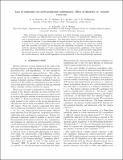Loss of coherence in cavity-polariton condensates: effect of disorder vs. exciton reservoir
Date
15/11/2016Metadata
Show full item recordAbstract
Time evolution of long-range spatial coherence in a freely decaying cavity-polariton condensate excited resonantly in a high-Q GaAs microcavity (MC) is found to be qualitatively different from that in nonresonantly excited condensates. The first-order spatial correlation function g(1)(r1, r2) in response to resonant 1.5 ps pump pulses at normal incidence leaving the exciton reservoir empty is found to be nearly independent of the excitation density. g(1) exceeds 0.7 within the excited spot and decreases very slowly in the decaying and expanding condensate. It remains above 0.5 until the polariton blueshift α|ψ2| gets comparable to the characteristic amplitude of the disorder potential δELP . The disorder is found to reveal itself at α|ψ2| ≤ δELP in fast and short-range phase fluctuations as well as vortex formation. They lead to oscillations in g(1)(t), but have little effect on the overall coherence, which is well reproduced in the framework of the Gross-Pitaevskii equations.
Citation
Demenev , A A , Grishina , Y V , Kulakovskii , V D , Schneider , C & Höfling , S 2016 , ' Loss of coherence in cavity-polariton condensates: effect of disorder vs. exciton reservoir ' , Physical Review. B, Condensed matter and materials physics , vol. 94 , no. 19 , 195302 . https://doi.org/10.1103/PhysRevB.94.195302
Publication
Physical Review. B, Condensed matter and materials physics
Status
Peer reviewed
ISSN
2469-9950Type
Journal article
Description
The work was supported by the Russian Science Foundation (Grant No. 14-12-01372) and the State of Bavaria.Collections
Items in the St Andrews Research Repository are protected by copyright, with all rights reserved, unless otherwise indicated.

